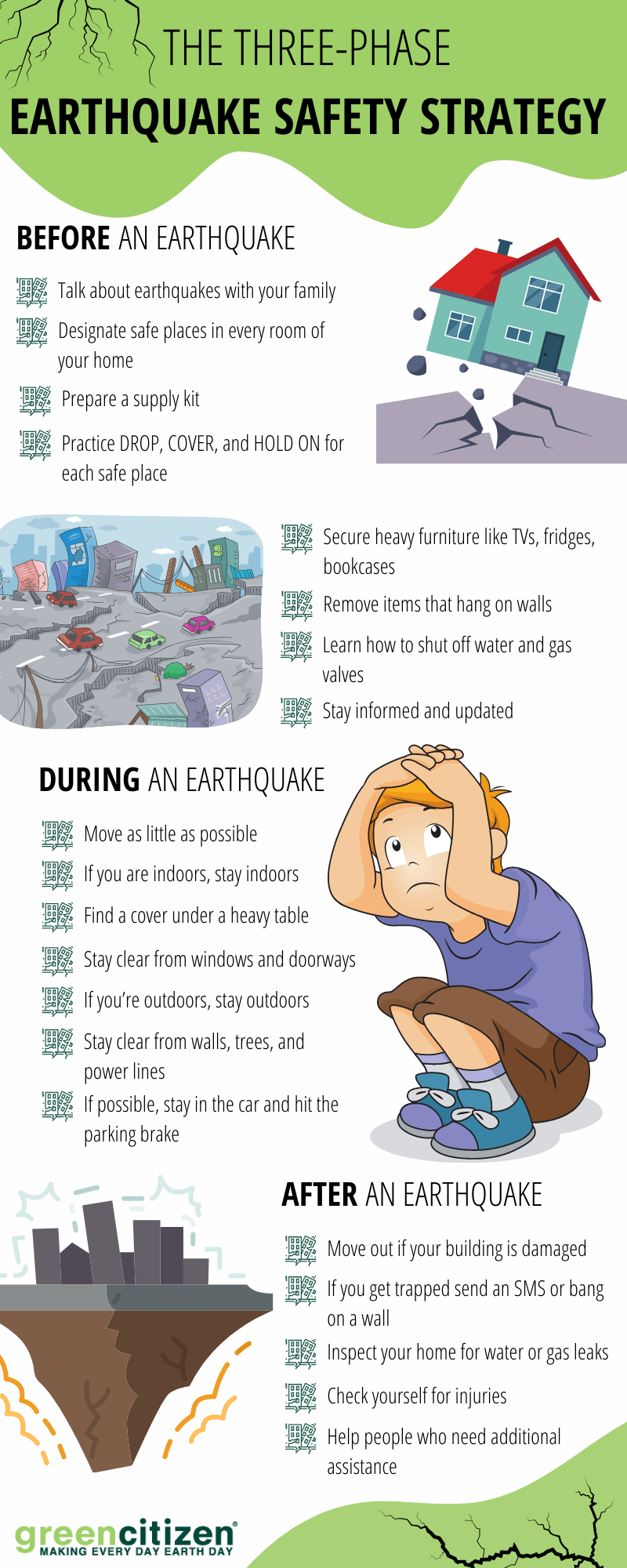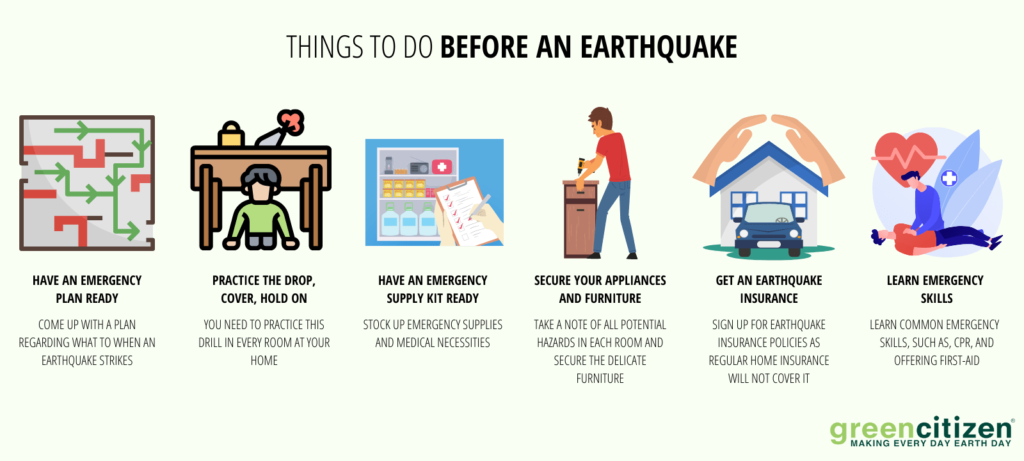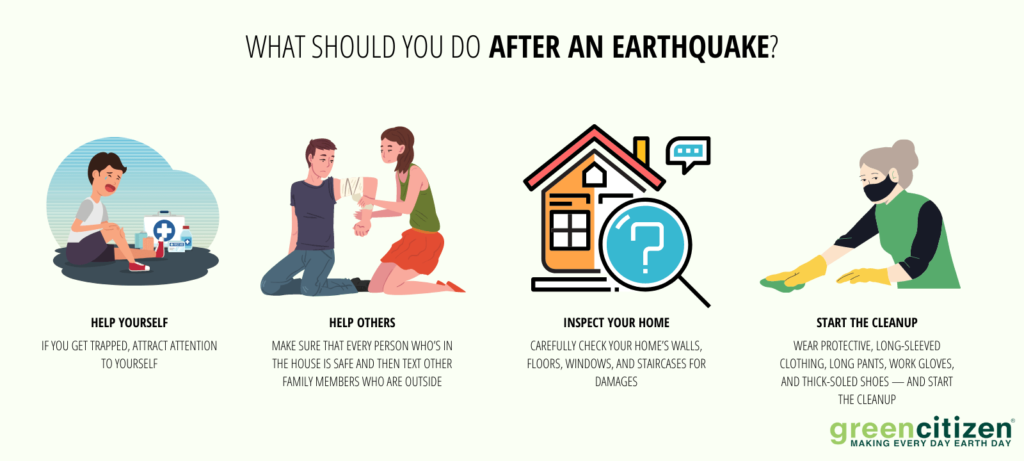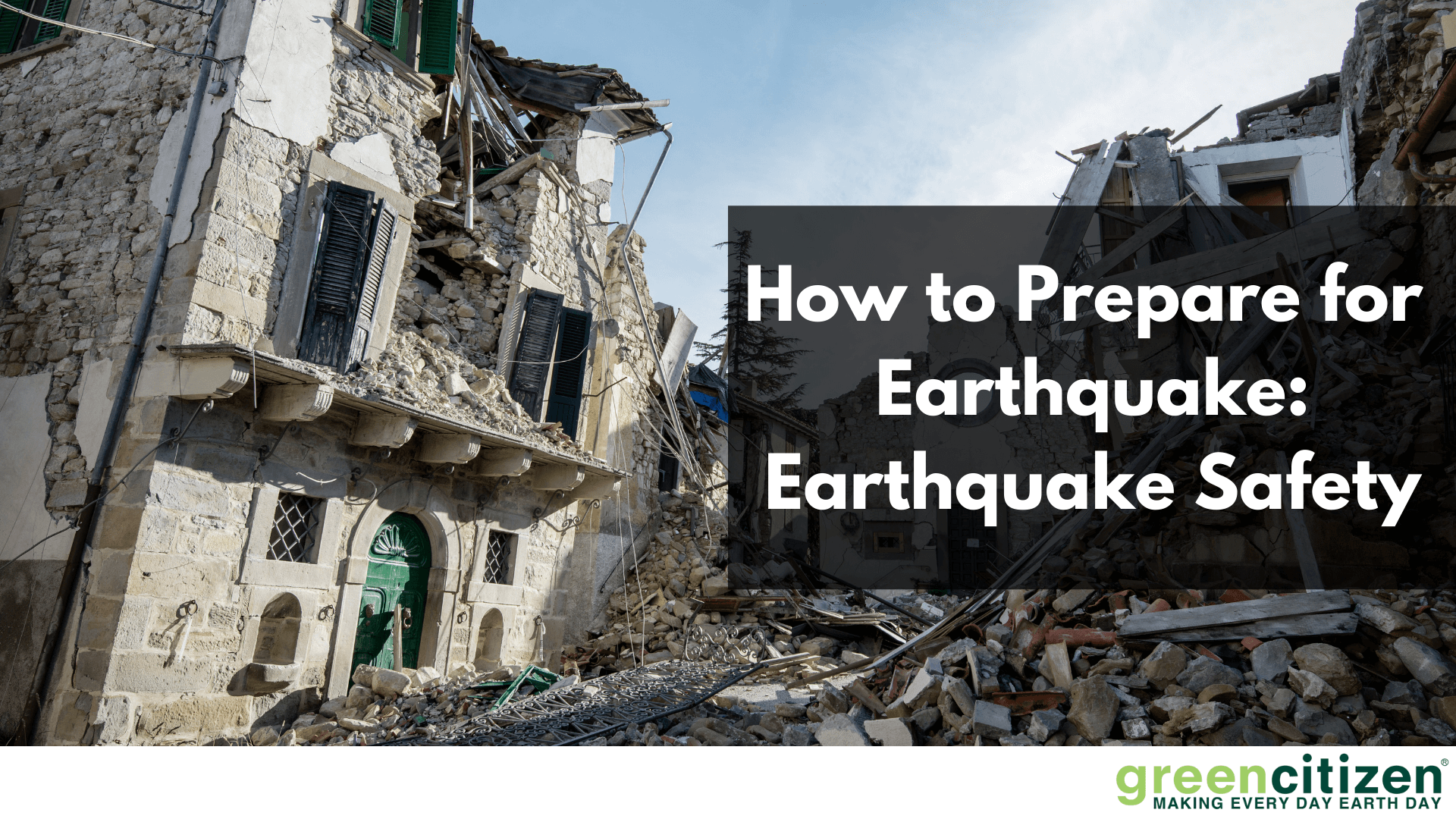In the past seven days, California was shaken by 11 earthquakes of magnitude 3.0 and above and 91 quakes between 2.0 and 3.0.
It’s always rockin’ and shakin’ in the Sunshine State, but for us, Californians, earthquakes are a tough reality.
To make it worse, scientists still can’t tell us when the next one will hit and how hard it will be.
But people like me have learned many earthquake safety tactics and tricks.
If you live in an earthquake-prone area, this is how you prepare for the next big one.
Why Is California at High Risk of Earthquakes?
When the next earthquake hits the United States, there is a 75% chance it will happen in California.
But what puts California at such a high risk?
What’s Under the Surface?
To answer this, we must go 200 million years in the past. When the supercontinent Pangea broke up into continents we have today, the rift between the Pacific and North American plates run roughly along what is today the US west coast.
These two plates are still setting in, creating many faults across California.
As a result, California has a relatively thin crust and high subterranean magma flow, both of which are ideal conditions for earthquakes to occur.
The first recorded earthquake in California occurred in 1769.
According to notes from members of a Spanish expedition who were charting a land route from San Diego to Monterey, the quake was “violent and occurring over the next several days”.
Notable Recent Earthquakes in California
In the past decade alone, the region has endured several strong earthquakes:
Antelope Valley — July 8, 2021
A series of earthquakes struck Little Antelope Valley, about 20 miles southwest of Smith Valley, Nevada. The largest, a 6.0 quake, was felt as far away as the San Francisco Bay Area and Sacramento.
Ridgecrest — 2019
This 7.1 earthquake struck 10.5 miles north-northwest of Ridgecrest in the Mojave Desert, a day after another 6.4-strong earthquake struck 7.5 miles southwest of the Searles Valley in the Mojave Desert. Multiple aftershocks were felt after both, but the latter was the strongest earthquake in the region in almost 20 years.
El Mayor-Cucapah — 2010
Centered in Baja California, this 7.2-strong earthquake was felt throughout Southern California, Arizona, and Nevada. There was much soil liquefaction, as well as widespread damage to farmlands, highways, homes, and public buildings.
To Frack or Not to Frack?
A controversial yet lucrative industry of fracking in the US is raising both environmental concerns and concerns about its link to earth tremors.
What is this all about?
In fracking, large amounts of water are used to fracture underground rock formations to extract oil and natural gas.
And there’s the first problem — fracking operations use huge amounts of water which must be transported to the site at a high cost to the environment.
Secondly, since fracking takes part far below the water table, potentially carcinogenic chemicals may escape during drilling and contaminate groundwater.
Finally, fracking weakens the faulted earth crust even more:
If high-pressure fracking liquid finds the existing fault it can unpin it a bit more and cause an earthquake.
And this is just what happened in China’s Sichuan Province in 2019 when an earthquake caused by hydraulic fracking injured 12 and killed two people.
The good news is that earlier this year, California’s Gov. Gavin Newsom announced that California banned fracking entirely by 2024.
Does Climate Change Have Any Effect on Earthquakes?
Although the “earthquake weather” myth has been busted a long time ago, today scientists want to know if there is any relation between climate change and the occurrence of earthquakes.
The Water Effect
Geophysicist Paul Lundgren at NASA and his colleague Jean-Philippe Avouac at Caltech have found that large amounts of rain during the monsoon season reduce the number of micro-earthquakes in the Himalaya.
During the winter dry season, the number of micro quakes peaks.
Although these tremors are relatively weak, no one can tell if shifting climate could bring on more sizeable earthquakes one day.
The Drought Effect
Between 2011 and 2017 the Sierra Nevada rose by almost an inch and then dropped by half that amount. High-precisions GPS measurements revealed this was caused by a period of alternating droughts and heavy rainfalls.
This proves that in periods of drought, the earth’s crust rises. Scientists found that these changes in stress loads promote lateral changes in stress between the two tectonic plates, which may cause earthquakes.
The Ice and Fire Theory
As glaciers retreat as a result of climate change, they reduce stress loads on the earth’s crust underneath, which in turn impacts the movement of subsurface magma.
A study of volcanic activity in Iceland between 4,500 and 5,500 years ago shows that eruptions declined then glacial cover increased.
Human Activity
Several studies link earthquake activity with fluctuations in man-made reservoirs. Seismicity decreases as reservoirs fill in winter and spring, only to increase in summer and fall when the water level is typically at the lowest.
Another study has linked an unusual increase in earthquake activity in Midwest and Eastern US states with an increase in the practice of injecting wastewater into the ground during oil operations.
Earthquake Preparedness Strategy: What to Do Before, During, and After?

Things to Do Before an Earthquake: Earthquake Safety Strategies
Have an Emergency Plan Ready
When you plan the earthquake safety procedure ahead, you and your loved ones can learn what to do exactly when the shaking starts.
Remember that when the footing becomes unstable, every second counts.
With the plan in place, everyone knows where the nearest safe spot is — under the dining table, by the bed, near an inner wall, etc.
In case my home gets badly damaged I made an evacuation plan from every room. The first meeting place is by the wooden garden shed in the backyard.
I strategically choose this place as there are no trees around.
This is where I keep my emergency supply kit.
Everyone can access it and there’s no danger of it getting trapped under the rubble.
Practice the Drop, Cover, Hold on with Your Close Ones
It may look like a kid’s game but this procedure can literally save your life. You need to practice this drill in every room at your home.
This is how it goes:
- DROP down on your hands and knees immediately. This position protects you from falling off your feet but lets you crawl to a safe place. It also protects your vital organs.
- COVER your head and neck, and your entire body if you can. Take shelter under a sturdy table. If you can’t find any cover in the room, get down near an interior wall or next to a bed or sofa.
- HOLD ON to your shelter or your head and neck until the tremor stops. If the shaking moves your shelter around, be ready to move with it.
Have an Emergency Supply Kit Ready
I keep a stock of emergency supplies that we can use immediately after an earthquake and in the days that follow.
Keep in mind that it may take a few days before public services are restored, so first and foremost, you need a first aid kit, a supply of medicines, and food and water for at least 3 days.
When I say water, I mean drinking water. If the utilities are disrupted, water for personal hygiene might become a luxury.
This is why you need hand sanitizer with at least 60% alcohol and no-shower body wipes.
All these products are cheaper when you buy them online in bulk.
I never know if I’ll have to rescue someone immediately, so my earthquake preparedness kit includes a firefighter axe with a pick for more leverage, a shovel, and a length of rescue rope with carabiners.
Now, I’m of no use to anyone if I get hurt in the first rescue attempt. Take my advice and pack a pair of rescue gloves and sturdy work boots to protect your feet from broken glass and nails.
An earthquake followed by fire is the last thing you need, so keep a multipurpose fire extinguisher close by. Multipurpose extinguishers let you deal with fires caused by common combustibles, liquids, and, most importantly, electrical equipment.
Remember, if you need to travel more than 40 feet to reach it, the extinguisher is too far.

Secure Your Appliances and Furniture
Take a note of all potential hazards in each room. These include windows and other glass surfaces, like cabinet doors and tabletops.
Now, I’m the last person to tell you how to decorate your home, but if you live in Southern California or anywhere in the world where earthquakes happen regularly, you may want to have as few glass elements as possible. The same goes for hanging fixtures.
Move on to securing the large appliances like the fridge, stove, and everything else that’s not built in the countertop. I recommend you use a flexible cable.
Finally, remove heavy mirrors and pictures from the walls, especially those above places where you sit or sleep. If you want to keep them where they are, anchor every piece with wire through eye screws bolted into wall studs.
Get an Earthquake Insurance
I can’t describe my disappointment when I found out that my standard home insurance policy doesn’t cover earthquake damage.
They said it covers losses from a fire that is caused by a quake if such a fire makes my home unlivable.
No thanks.
That’s when I asked around and discovered California Earthquake Authority (CEA) Insurance.
CEA earthquake insurance can protect your house, condo-unit, mobile home, and even your valuables.
This is especially important if you’re renting — your landlord might be responsible for broken windows and cracked drywall, but your possessions are your responsibility alone.
The best thing is that CEA’s renter earthquake insurance is flexible so you get to choose what you want to insure.
Learn Emergency Skills
You may emerge unscathed but others around you may not be as lucky. When the shaking stops you need to pull yourself together, get your protection gear and tools, and see if anyone needs help.
In those situations you should know how to:
Perform CPR and use First Aid
Your local Red Cross chapter is a great place to start. When you complete your training you receive a certification that protects you under Good Samaritan laws if you ever get sued for having to give first aid.
Trust me, it happens all the time.
Use a Fire Extinguisher
As I already mentioned, you should get a multipurpose fire extinguisher that is safe to use with different types of fires.
Every extinguisher has visual instructions on what you should do, but if you want to try one for real, contact your local fire department and see what training they offer.
I’ve gone through it and it was as educational as it was fun.
Shut off Utilities
Leaking natural gas can cause a fire or explosion. If you have the reason to believe that an earthquake is coming, make sure you know how to turn off your gas supply. The main gas valve is always located outside, next to the meter box.
The same goes for the main water valve. Again, it’ll be somewhere outside, right next to the water meter.
Finally, you need to show every responsible family member how to safely shut off the electricity.
What to Do During an Earthquake?
They say that sometimes seconds before an earthquake you may hear a distant rumbling sound. I’ve never heard to tell you the truth.
On the other hand, if you feel that the footing is giving up, you need to immediately DROP down on your hands and knees, crawl to the nearest COVER, and HOLD ON to it.
Case 1 — You’re Inside
Don’t try to get outside. This is the easiest way to get hurt. Just stay away from glass objects and things that may fall on you.
I’ve heard many times that you should stand in a doorway. Well, this might have been good advice back in the day when homes were built differently, with much sturdier beam supports.
In modern homes, the doorway is no stronger than any other part of the house. So, it’s much safer to crawl under a heavy table or duck near a stable piece of furniture while protecting your head with a pillow or a large book.
Most earthquake-related injuries are caused by flying and falling objects such as TVs, heavy frames, bookcases, shelves, etc.
If you find yourself in a high-rise building, don’t use the elevators, as the electricity may go out at any moment.
Your first reaction may naturally be to rush for the exit. This is what many people will try so, just stay put at the moment.
Case 2 — You’re Outside
If I had a choice, I’d always rather be outside than inside when an earthquake strikes. That is if I can easily move away from buildings, power lines, and trees.
You’ll get the best chances if you move to an open area, get down low, and stay there until the shaking stops.
The worst place to be is near the outside walls of buildings. Windows, facades, and architectural features are often the first parts to collapse.
If you’re in a stadium or theater, remain calm in your seat. Get into a sitting fetus position and cover your head and neck.
If you’re near the shore, drop, cover, and hold until the shaking stops. If the shaking lasts more than 20 seconds, evacuate top high ground immediately, as such a powerful earthquake may as well generate a tsunami.
Don’t wait for broadcast warnings.
Move intend at least 2 miles or to a point that is at least 30 meters above sea level.
This is where you should walk rather than drive, as the traffic will probably become a nightmare by then, especially if the roads are already blocked by debris.
This brings us to the next scenario:
Case 3 — You’re in a Car
At the first sign of shaking, move your car to the shoulder, away from power lines, street lighting poles, and overpasses.
Put the shifter into “P” and engage the parking brake. The car may rock violently on its springs, but it’s one of the safest places to be.
Turn on the radio and listen to the emergency broadcasts.
When it’s safe to drive again, watch for road damage and other hazards such as leaning trees and utility poles and collapsed overpasses.
I live in a mountainous area, so I’m used to seeing rocks other debris that has rolled down the slopes. This is not a time for speeding.
What Should You Do After an Earthquake?
After an earthquake, you may feel several aftershocks. These are smaller earthquakes that follow a large one. They can happen minutes, days, and even weeks after an earthquake.
Although they are usually weaker than the main earthquake that created them, be ready to DROP, COVER, and HOLD ON again.
Help Yourself
If you get trapped, attract attention to yourself. Shouting won’t get you anywhere and you only risk inhaling more dust. Instead, bang on a pipe or a part of a steel structure.
Call me a prepper but I like to have a whistle on myself at all times. This one easily blends in on my key ring.
Otherwise, get to your first aid kit and treat any small wounds to prevent infection.
Help Others
Once you take care of yourself, help others in need. Make sure that every person who’s in the house is safe and then text other family members who are outside.
Your priority should be infants, people with disabilities, older adults, people who live alone, and large families who need additional help.
You might have prepared your emergency kit, but clothes may have not. Be a good neighbor and keep that fire extinguisher close at hand.

Inspect Your Home
Carefully check your home’s walls, floors, windows, and staircases for damages. If you see cracks or missing support beams, don’t try to go any further.
You may need to find another safe location for the night.
Also, check the utility lines for damage. If you smell gas, see a burst water pipe, or a broken electrical line, turn off the utilities immediately.
IMPORTANT! You can shut off gas yourself, but only a professional can turn it on.
Unless you’re sure there are no gas leaks, don’t use matches, lighters, or electrical appliances in the house.
If it’s getting dark, use an LED flashlight instead of candles.
Open cabinet and closet doors carefully as the contents may have shifted.
If your home or property is damaged, take photos and videos to document your damage. This will make settling insurance claims much easier.
Start the Cleanup
Wear protective, long-sleeved clothing, long pants, work gloves, and thick-soled shoes. Wear an N95 mask at all times, and maintain a physical distance while working with someone else.
People with asthma and other lung conditions should not take part in the clean-up, as buildings will likely be full of dust. Water leaks may also cause mold growth.
If you need to move heavy or bulky objects have at least one person helping you.
Your first task is to clean up spilled medications, cleaning supplies, oil, gasoline, and other liquids that may become fire or slipping hazards.
Throw away all perishable food that is visibly damaged or hasn’t been refrigerated due to power outages. Until your local health department announces that tap water is safe to drink, use bottled water.
While cleaning up, remember to take care of yourself and rest when you need to.
Is There Any Smartphone App That Can Help?
MyShake
When your phone is stationary, this app uses its motion sensors to collect data, deciding which tremors are produced by earthquakes and which aren’t.
When MyShake detects an earthquake, it shares the data through its network of phones so every user can get an alert. Android and iPhone supported.
Earthquake – Alerts and Map (for iOS)
Using the latest worldwide data from several sources, this application sends you push notifications. You can see a map with different sized and colored circles that represent magnitude and age.
It lets you filter events by area, magnitude, and country. This app is more than just an earthquake alert — it’s packed with all kinds of maps, graphs, and data for a real earthquake enthusiast! iPhone only.
Earthquake Network (for Android)
This app gives your real-time earthquake alerts using Earthquake Network. Just like MyShake, this app turns your smartphone into a mobile earthquake sensor.
However, when the app detects an earthquake in your area, it automatically sends your coordinates to a list of trusted contacts. So even if the communications are down, rescuers know your last location. Android only.
Conclusion
Unlike storms, floods, and wildfires, no one can tell us when the next earthquake is going to strike.
In addition to their destructive power, the element of surprise is what makes these seismic events so dangerous.
This is why we should be prepared at all times and have a strong mindset which only comes from knowing exactly what to do in a time of distress.
If you have questions or want to know more about earthquake safety, feel free to ask.



